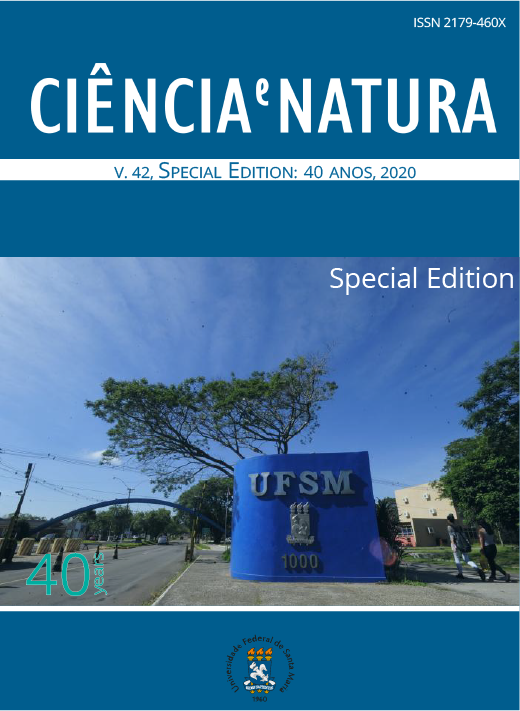Gênese e probabilidade ocorrência de tornados no Rio Grande do Sul, Brasil
DOI:
https://doi.org/10.5902/2179460X40840Palavras-chave:
Eventos extremos, Histórico, Tornados, Circulação Atmosférica, RSResumo
Com o objetivo de estudar a gênese dos tornados no Rio Grande do Sul, foi feito um banco de dados, utilizando dados de canais de meteorologia, jornais das cidades dos registros e trabalhos publicados para encontrar registros confirmados. Com auxílio das Cartas Sinóticas da Marinha do Brasil e das imagens de satélite do INPE analisadas no dia de cada evento, identificaram-se os sistemas atmosféricos que estiveram presentes no dia dos registros dos tornados. Ainda foi identificada a sazonalidade dos eventos registrados.
Downloads
Referências
BECK AT, VERZENHASSI, CC. Reliability Based Risk Optimization. In: 4th International ASRANet Colloquium, Atenas, Grecia: ASRANet Ltd., 2008.
BURROUGH PA, McDONNELL RA. Principles of Geographical Information Systems. Nova York: Oxford University Press, 1998
CANDIDO DH. tornados e trombas d'água no Brasil: Desenvolvimento de um modelo e proposta de escala de avaliação de danos. 2012. 230 f. Tese (Doutorado em Geociências) – Universidade Estadual de Campinas. 2012.
CARTAS SINÓTICAS. Centro de Hidrografia da Marinha. Disponível em: https://www.marinha.mil.br/chm/dados-do-smm-cartas-sinoticas/cartas-sinoticas. Acesso em: Junho de 2019.
COPPOCK JT. GIS and natural hazards: an overview form a GIS perspective. In: CARRARA, A.; GUZZETTI, F. (Ed.) Geographical information systems in assessing natural hazards. Dordrecht: Kluwer Academic Publishers, 1995.
DYER RA. A review of tornado activity in Brazil. In: International Society for Photogrammetry and Remote Sensing, 7., 1994, Rio de Janeiro. Anais... São José dos Campos: INPE, v. 30 part 7a, 1994, p.203-213.
IBGE. Bases e referencias. Disponível em: https://mapas.ibge.gov.br/bases-e-referenciais/bases-cartograficas/malhas-digitais. Acesso em: agosto de 2019.
IENSSE AC. CIRCULAÇÃO ATMOSFÉRICA REGIONAL E A OCORRÊNCIA DE TORNADOS E TROMBAS D'ÁGUA NO RIO GRANDE DO SUL, NO PERÍODO DE 2001 A 2015. 70p. (Trabalho de Graduação) – Universidade Federal de Santa Maria. 2015.
NASCIMENTO EL. Previsão de tempestades severas utilizando-se parâmetros convectivos e modelos de mesoescala: uma estratégia operacional adotável no Brasil. Revista Brasileira de Meteorologia, São José Dos Campos, v. 20, n. 1, p.121-140, 15 fev. 2005.
NIMER E., "Clima Região Sul". in: Geografia do Brasil, v 2. IBGE, Rio de Janeiro, 1990
RECKZIEGEL BW. Levantamento dos desastres desencadeados por eventos naturais adversos no Estado do Rio Grande do Sul no período de 1980 a 2005. 2007. 370 f. Dissertação (Mestrado em Geografia) – Universidade Federal de Santa Maria, Santa Maria, 2007.
REDEMET. Rede de Meteorologia do Comando da Aeronáutica. Disponível em: https://www.redemet.aer.mil.br/index.php. Acesso em: agosto de 2019.
SLEIMAN J. Veranicos ocorridos na porção noroeste do Estado do Rio Grande do Sul entre 1978 e 2005 e sua associação às condições climáticas da atmosfera. 164p Dissertação (Mestre em Geografia) - Universidade de São Paulo. 2008.
WOLLMANN CA, GALVANI, E. Caracterização Climática Regional Do Rio Grande Do Sul: Dos Estudos Estáticos Ao Entendimento Da Gênese. Revista Brasileira de Climatologia. Ano 8 - Vol 11 Jul/Dez. 2012.
Publicado
Como Citar
Edição
Seção
Licença
Para acessar a DECLARAÇÃO DE ORIGINALIDADE E EXCLUSIVIDADE E CESSÃO DE DIREITOS AUTORAIS clique aqui.
Diretrizes Éticas para Publicação de Revistas
A revista Ciência e Natura está empenhada em garantir a ética na publicação e na qualidade dos artigos.
A conformidade com padrões de comportamento ético é, portanto, esperada de todas as partes envolvidas: Autores, Editores e Revisores.
Em particular,
Autores: Os Autores devem apresentar uma discussão objetiva sobre a importância do trabalho de pesquisa, bem como detalhes e referências suficientes para permitir que outros reproduzam as experiências. Declarações fraudulentas ou intencionalmente incorretas constituem comportamento antiético e são inaceitáveis. Artigos de Revisão também devem ser objetivos, abrangentes e relatos precisos do estado da arte. Os Autores devem assegurar que seu trabalho é uma obra totalmente original, e se o trabalho e / ou palavras de outros têm sido utilizadas, isso tem sido devidamente reconhecido. O plágio em todas as suas formas constitui um comportamento publicitário não ético e é inaceitável. Submeter o mesmo manuscrito a mais de um jornal simultaneamente constitui um comportamento publicitário não ético e é inaceitável. Os Autores não devem submeter artigos que descrevam essencialmente a mesma pesquisa a mais de uma revista. O Autor correspondente deve garantir que haja um consenso total de todos os Co-autores na aprovação da versão final do artigo e sua submissão para publicação.
Editores: Os Editores devem avaliar manuscritos exclusivamente com base no seu mérito acadêmico. Um Editor não deve usar informações não publicadas na própria pesquisa do Editor sem o consentimento expresso por escrito do Autor. Os Editores devem tomar medidas de resposta razoável quando tiverem sido apresentadas queixas éticas relativas a um manuscrito submetido ou publicado.
Revisores: Todos os manuscritos recebidos para revisão devem ser tratados como documentos confidenciais. As informações ou ideias privilegiadas obtidas através da análise por pares devem ser mantidas confidenciais e não utilizadas para vantagens pessoais. As revisões devem ser conduzidas objetivamente e as observações devem ser formuladas claramente com argumentos de apoio, de modo que os Autores possam usá-los para melhorar o artigo. Qualquer Revisor selecionado que se sinta desqualificado para rever a pesquisa relatada em um manuscrito ou sabe que sua rápida revisão será impossível deve notificar o Editor e desculpar-se do processo de revisão. Os Revisores não devem considerar manuscritos nos quais tenham conflitos de interesse resultantes de relacionamentos ou conexões competitivas, colaborativas ou outras conexões com qualquer dos autores, empresas ou instituições conectadas aos documentos.






